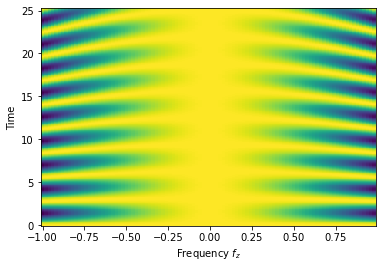[6]:
import quanguru as qg
import numpy as np
import matplotlib.pyplot as plt
import platform
11 - Sweep and two term Qubit Hamiltonian#
In previous tutorials, we simulated the dynamics of a single qubit with a single term in its Hamiltonian and explained the compute function and parameter sweep. In this tutorial, we use again a single qubit but with two terms in its Hamiltonian. As you will see below, we don’t need to change any part of the existing single term simulation, but we simply add a new term to our qubit.
Here, we will evolve a qubit under the unitary dynamics of the Hamiltonian \(H=\frac{1}{2}f_{z}\sigma_{z} + f_{x}\sigma_{x} = f_{z}J_{z} + f_{x}\sigma_{x}\) with the initial state set to the equal superposition of \(|1\rangle\) and \(|0\rangle\). We also set the total simulation time (with simTotalTime) and the step size (simStepSize) as well as the frequency sweep and the compute function where we compute the expectation value of \(\sigma_{x}\).
[7]:
# create the qubit and set its initial state and frequency
qub = qg.Qubit(frequency = 1)
qub.initialState = [1, 0]
# set the simulation time and step size
qub.simTotalTime = 8*np.pi
qub.simStepSize = 0.1
# create the operators for which we compute the expectation values
sigmaX = qg.sigmax()
# write a compute function that takes two arguments: (i) a quantum-system (qsys) and (ii) a state
# compute whatever we want and store in .resultsDict
def compute(qsys, state):
qsys.resultsDict['sigmax expectation'].append(qg.expectation(sigmaX, state))
# set the compute attribute of our qubit to compute function
qub.compute = compute
# create a sweep for the qubit frequency
freqSweep = qub.simulation.Sweep.createSweep(system=qub, sweepKey="frequency", sweepList=np.arange(-1, 1, 0.02))
Now, the only thing needed is to add the second term of the Hamiltonian to our qubit. We do this by calling the addTerm method as explained in previous tutorials, and the rest is the same.
[8]:
secondTerm = qub.createTerm(operator=qg.sigmax, frequency=1)
At this point, all the essential information are set, and we can run the simulation by qub.runSimulation(). We again set simDelState = True (to discard the states) and p = True (for multi-processing of the sweep).
IMPORTANT NOTE FOR WINDOWS USERS : MULTI-PROCESSING (p=True) DOES NOT WORK WITH NOTEBOOK
You can use a python script, but you will need to make sure that the critical parts of the code are under if __name__ == "__main__": We are going to add further tutorials for this later.
[9]:
qub.simDelStates = True
states = qub.runSimulation(p=(platform.system() != 'Windows'))
Now, we receive the results that we stored again as qub.resultsDict['sigmax expectation'], but this time it returns a list of list, each of which is a time trace corresponding to the frequencies swept.
As expected, the expectation value of \(\sigma_{x}\) oscillates with different frequencies.
[10]:
Y, X = np.meshgrid(qub.simulation.timeList, freqSweep.sweepList)
plt.pcolormesh(X, Y, qub.resultsDict['sigmax expectation'])
plt.xlabel("Frequency $f_{z}$")
plt.ylabel("Time")
[10]:
Text(0, 0.5, 'Time')

[ ]: